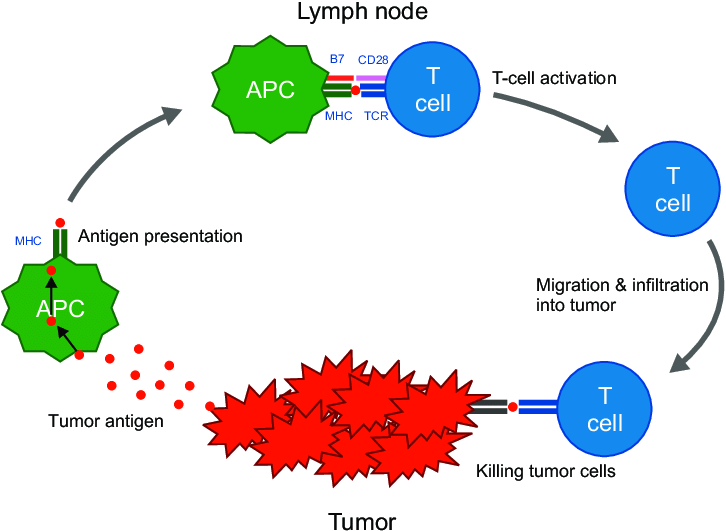
1/ There is a complex set of interactions that must go on between a tumor and its surroundings. It has to interact with the tissue cells, it needs nutrients, it needs oxygen, it needs to survive and proliferate in a hostile environment.
2/ One of the many things it has to achieve to exist and thrive is to overcome the immune system and its natural ability to find, target and destroy tumors. There are 3 key cells in the immune system that are designed to find and kill cells that are infected or defective. 

3/ They are the Natural Killer (NK) cell, the Cytotoxic T cells, and the Macrophage. The NK cells deploy a set of damage receptors called Damage Associated Molecular Patterns (DAMPs) that recognize stressed cells. This can be things like Mic-a or Mic-b. 

4/ Normal cells will express MHC I on their surface that tells the immune system they are healthy. These MHC I receptors are made up of an alpha chain and a beta chain.
5/ Defective cells will often display just 1 chain called MIC-a for the MHC I Chain related alpha chain or MIC-b for the MHC I Chain related beta chain. This is just one of the many ways NK cells can recognize an unhealthy cancer cell. 

6/ The Cytotoxic T cells can detect Tumor Associated Antigens (TAA) which are just mutated versions of the normal self proteins. This can cause T cell activation and a cell mediated response. The Cytotoxic T cells will bind to and kill tumor cells that display their antigen. 

7/ The last cells that are key are the Antigen Presenting Cells (APCs) like the Dendritic cells and Macrophage. The tumor not only competes with the healthy tissue for survival, but the cancer cells will battle each other in a survival of the fittest.
8/ There is a lot of cell death going on in the tumor. This naturally allows APCs like the Macrophage to clean up these dead cells and process TAA antigens. They can present these antigens to the T cells to activate a response. 

9/ One of the hallmarks of tumor progression is the tumor evolves mechanism to evade the immune response. There are multiple ways the tumor will evade or redirect the immune system.
10/ The most common is the tumor cells will release signals that will recruit T regulatory cells and Myeloid Derived Suppressor Cells (MDSC) to the tumor which will promote tolerance by releasing signals that inactivate the immune cells like T cells and APCs. 

11/ This is one of these hardest effects to overcome in the tumor microenvironment. One effective way to clear all these cells is the use of a lymphodepletion regiment like Flu/Cy. This works in cell therapies to clear the battle field.
12/ The next mechanism the tumor cells will deploy is the expression of immune cell suppressing receptors like PD-1, CTLA-4 and CD-47. These will engage with T cells and Macrophages and inhibit them from cell killing. We call them checkpoints as they stop the immune response. 

13/ There is a huge amount of development going on to understand all the interactions between the immune cells and the tumor. There has been some great success with PD-1 and CTLA-4 and a lot of disappointments along the way trying to develop checkpoint inhibitors.
14/ Some of the early developing checkpoints are LAG-3, TIM-3, TIGIT and CD47. All of these are natural receptors used by healthy cells to block the immune system from killing any healthy tissues like with PD-1.
15/ The problem is the Tumor cells mutate to exploit this system to block the immune system and protect the tumor cells.
16/ The critical role of the immune system in protecting us from cancer has been well established by following patients who are immune suppressed from cancer treatments or organ transplants.
17/ Immune compromised patients have a significant risk for cancer. Even HIV patients will have higher risk of cancer related to the immune suppression of the virus. Some cancer patients get secondary cancers while their immune systems are suppressed from chemotherapy.
18/ The role of the immune system in oncology is now well established. The many interactions that play a role in cancer surviving in a healthy immune system is still developing.
• • •
Missing some Tweet in this thread? You can try to
force a refresh





